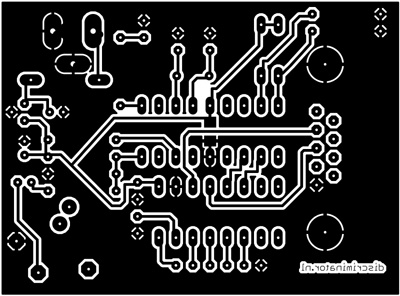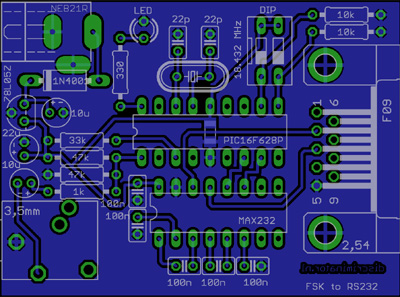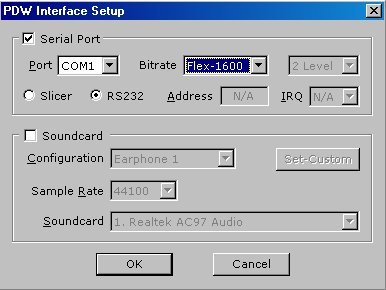RS232 INTERFACE PDW AND THE RS232 PORT THERE IS
HOW TO MAKE RS232 CONNECTION CABLE DIRECTLY TO1 RS232RS485RS422 FIBER OPTICAL MODEM U SER’S MANUAL VERSION
8 PORT RS232 PCI CARD D ESCRIPTION
ADAPTÉR USB – 1X LPT PORT + 1X RS232
ART NO 1900019009 PRODUCT RS232 DSUB9DSUB9 PAGE 1 OF
BASIC (SINGLE COMMAND) RS232 COMMUNICATION USING HYPERTERMINAL BY ROCHELLE
RS-232 Interface
PDW and the RS232 port
There is an increasing lack of PC's with serial ports these days. Decoding data networks such as Flex, POCSAG and Mobitex on a computer without RS232 port is only possible using the PC's soundcard. A USB to serial converter in combination with a 2 level interface won't work.
PDW doesn't use the normal RS-232 TxD/RxD lines, but uses the status lines (CTS, DSR, DTR). The 'abuse' of these lines for PDW purposes does not comply with the standard RS-232 protocol. If you have direct control over the serial port (i.e. through a physical port) you can sample these lines without a problem. If you use a USB to RS-232 converter, all serial communications goes through the converter's driver and PDW doesn't have direct control.

Data communication protocols like Flex, POCSAG and Mobitex use synchronous communication: a steady flow of ones and zeros. An RS-232 port is made for asynchronous communication: start bit, data bits, stop bit. The serial interface presented here takes care of conversion.
Using standard RS232 communication enables the user to
Use a serial to USB converter of choice
Use a serial PCMCIA or PCI card
Run PDW on any Microsoft Windows version, including Vista and 7
Run multiple instances of PDW on one PC (one user even reported 8 concurrent windows)
Use a serial to Bluetooth adapter for wireless monitoring
Monitor remotely by using a serial to Ethernet converter
Run PDW in Wine under Linux (who's going to develop a Linux version of PDW?)
How does the interface work?
The new serial interface converts the synchronous (continuous) datastream into an asynchronous data signal with a start bit, 8 data bits and one stop bit. The interface works according to the next priciples:
The incoming signal is sampled with 5 times the data speed. So e.g. a FLEX-1600 signal is sampled 8000 times per second
The transitions from 0 to 1 and from 1 to 0 are used for bit synchronisation. Ideally, when receiving data, these 5 samples will be 11111 or 00000. If the 5 samples received are e.g. 11110 or 10000, resynchronisation needs to take place: one sample to the right resp. one sample to the left
The majority of the 5 samples determines whether a 0 or 1 bit has been received
When 8 bits have been received, these are sent to the serial port observing the standard RS232 protocol with 19200 bit/s , 8N1 (8 data bits, no parity bit, 1 stop bit)

Apart from the bit synchronization, the interface doesn't contain any intelligence. The only thing the interface does is chopping a synchronous data signal into slices of 8 bits and sending these 8 bits asynchronously, i.e. packing them with start- and stopbits, according to the RS-232 protocol.
Interface Hardware
The new RS-232 interface is based on a cheap and common PIC16F628 microprocessor. It runs on a frequency of 18.432 MHz. This microprocessor has a built-in comparator ('2 level interface') and a hardware UART. To convert the output signal to RS232 levels (-10V / +10V), a MAX232 is used.
A standard RS-232 output is implemented, not a USB port. Next to the advantages mentioned earlier, the reason is that USB chips only come in SMD (Surface Mounted Devices). The circuit presented here only uses DIL (dual inline) components, making it easier to assemble the circuit board. Further to that, the circuit board is single sided, facilitating DIY production.
Using two DIP switches, 4 data speeds can be selected. Tentatively, the following speeds can be selected:
512 bit/s (POCSAG 512)
1200/2400 bit/s (combined setting for POCSAG 1200, 2400 and 1200/2400)
1600 bit/s (FLEX 1600)
8000 bit/s (Mobitex)
Other speeds can be programmed on request.


Circuit board design
Component placement
Changes PDW
To use this interface, you should download the latest version of PDW (version 3.x). In the 'Interface' settings in PDW from version 3.0, the user can now choose between 'Slicer' (the 'standard' 2 or 4 level interface) or 'RS232' (the new serial interface). It takes some getting used to this: changing between different data standards requires the user to change the settings on both the interface and in PDW.
Status
Since its introduction in September 2010, tens of interfaces have found their way to satisfied users worldwide. You can order a built and tested interface, or just the circuit board plus a programmed and tested microprocessor if you want to build the interface yourself.

Prices and 'Buy Now'-buttons for instant ordering can be found on the Order page.
A final remark
Without the efforts of Peter Hunt to adapt PDW, this interface would not have existed. Therefore, for each sold interface or circuit board and microprocessor, a donation to him is made
|
|
DYMEC RS232RS485RS422 SERIAL TO FIBER CONVERTER AUTOSHAPE 23 AUTOSHAPE
E P716719R SERIES RS232 PROTOCOL FUNCTION LIST INTERFACE
INSTRUKCJA OBSŁUGI TERMOHIGROMETR Z RS232 DE3009 SPIS TREŚCI 1
Tags: rs232 port, to rs232, rs232, interface, there
- FORMATO 3 ACTA DE ASAMBLEA CIUDADANA CONVOCADA POR EL
- CULTURA AUDIOVISUAL II “EL ECOSISTEMA PUBLICITARIO” 2º TRIMESTRE PRÁCTICA
- KOREA BUSINESS CENTER ISTANBUL YAPI KREDI PLAZA BBLOK KAT10
- NA TEMELJU ČLANKA 29 STAVAK 6 UREDBE O KRITERIJIMA
- UBUNTU PRACTICE AND CONFIGURATION POST INSTALLATION EXERCISES INTERLAB AT
- MATHINCTE LESSON PLAN TEMPLATE LESSON TITLE BRAKE ROTORS LESSON
- Police Training in Pristina Kosovo Under Unscr 1244 22nd–
- IZJAVA SPODAJ PODPISANAI IZJAVLJAM DA DOVOLJUJEM OBJAVO SVOJIH
- HISTORIA DEL MUNDO CONTEMPORÁNEO 1° DE BACHILLERATO PROGRAMACIÓN MUESTRA
- XIII REGIONALNO SAVETOVANJE IZ KLINIČKE PATOLOGIJE I TERAPIJE CLINICA
- Regulamin Konkursu o Nagrodę im Prof Jerzego Skowronka 2023
- TENDER RESPONSE SCIRPUITTMSQN2016003 PLEASE PROVIDE INFORMATION AGAINST EACH REQUIREMENT
- REPORT OF STUDENT VIOLATION OF THE ACADEMIC DISHONESTY POLICY
- OBRAZEC 6 VLOGA ZA IZDAJO POTRDILA ZA VOZNIKA KI
- MÜZİKSEN DENETİM KURULU RAPORU (MÜZİKSEN) MÜZIK VE SAHNE SANATÇILARI
- Rzeszów dn 23082022 r Regulamin Zawodów w Pięcioboju Myśliwskim
- GRAD KARLOVAC UPRAVNI ODJEL ZA OPĆE I IMOVINSKO PRAVNE
- FICHA TÉCNICA CLASIFICADOR DE PRODUCTOS DE CUBA SIGLA CPCU
- Opole 24 Luty 2022 r Regulamin Zawodów Pięcioboju Myśliwskim
- BASIC BRAILLE AT HOME (BBH) – NEW SOFTWARE PROGRAM
- FICHA TÉCNICA BARCELÓ HOTEL GROUP BARCELÓ HOTEL GROUP LA
- ESTIMADS COMPAÑERS LA FEDERACIÓN ESPAÑOLA DE ASOCIACIONES DE FUNCIONARIOS
- EL LENGUAJE ALGEBRAICO UNIDAD DIDÁCTICA INTRODUCCIÓN EL LENGUAJE ALGEBRAICO
- U SUSRET OLIMPIJSKIM IGRAMA POSLJEDNJE PRIPREME U GOSPIĆU
- MAYOR GARCETTI LAUNCHES NATION’S FIRST CITYBASED CYBER LAB PUBLICPRIVATE
- 10 PRONUNCIAMIENTO Nº 4202013DSU ENTIDAD FUERZA AÉREA DEL PERÚ
- PERFORMANCE AND AUDIT PANEL ANNUAL REPORT 20042005 MEMBERSHIP COUNCILLORS
- ПОЗИВ НАРУЧИОЦА НАБАВКА ДОБАРА – ВАТРОГАСНИ АПАРАТИ НАБАВКА НА
- ŻELAZNA DN 20 LUTY 2020 R NR SPRAWY 3RZD
- ENNISCORTHY ELECTORAL AREA GOREY ELECTORAL AREA NEW ROSS ELECTORAL
 RAPPORT 2006 DE L’OBSERVATOIRE DES MINES VERS UN
RAPPORT 2006 DE L’OBSERVATOIRE DES MINES VERS UNALCOHOL CONSUMPTION REGULATIONS (ON AND OFF CAMPUS) I STUDENT
 PAN AMERICAN HEALTH ORGANIZATION REGIONAL OFFICE OF THE WORLD
PAN AMERICAN HEALTH ORGANIZATION REGIONAL OFFICE OF THE WORLD SERVICIO DE ADMINISTRACIÓN TRIBUTARIA SECRETARIA DE HACIENDA Y CREDITO
SERVICIO DE ADMINISTRACIÓN TRIBUTARIA SECRETARIA DE HACIENDA Y CREDITO ZAŁĄCZNIK NR 3 DO ZAPYTANIA OFERTOWEGO NR 6POWER2019 OŚWIADCZENIE
ZAŁĄCZNIK NR 3 DO ZAPYTANIA OFERTOWEGO NR 6POWER2019 OŚWIADCZENIE RECTANGLE 3 RECTANGLE 4 RECTANGLE 5 SUGGESTED GOAL SETTING
RECTANGLE 3 RECTANGLE 4 RECTANGLE 5 SUGGESTED GOAL SETTINGO HORIZONTE FICA MUITO LONGE? A IMENSIDÃO DOS GRANDES
4708 SAYILI YASA ÇERÇEVESINDE DENETÇISI MIMAR VE MÜHENDISLERIN HUKUKI
LA ECONOMÍA DE LA SOLIDARIDAD O LA VUELTA DE
 A QUITOSANA COMO ESTRATÉGIA NO TRATAMENTO DE EFLUENTES MARINA
A QUITOSANA COMO ESTRATÉGIA NO TRATAMENTO DE EFLUENTES MARINASEPTEMBER 5 2003 HONORABLE INEZ M TENENBAUM STATE SUPERINTENDENT
 PROPUESTAS DE ENMIENDAS DEL CERMI DE MODIFICACIÓN DEL PROYECTO
PROPUESTAS DE ENMIENDAS DEL CERMI DE MODIFICACIÓN DEL PROYECTO INITIAL FILING SUBSEQUENT FILING FIRST REPORT OF INJURY (FROI)
INITIAL FILING SUBSEQUENT FILING FIRST REPORT OF INJURY (FROI)LAURA OLSON IS A SENIOR RESEARCH FELLOW AT THE
EVIDENČNÍ ČÍSLO SMLOUVY SMLOUVA O POSKYTNUTÍ ÚČELOVÉ INVESTIČNÍ DOTACE
INFORMACJA NA TEMAT WYKAZU ORGANIZACJI POŻYTKU PUBLICZNEGO UPRAWNIONYCH DO
 NOMBRE ESTUDIANTE NIVEL 1º ASIGNATURA HISTORIA GEOGRAFÍA Y CIENCIAS
NOMBRE ESTUDIANTE NIVEL 1º ASIGNATURA HISTORIA GEOGRAFÍA Y CIENCIAS C RONICA FESTIVAL BLUES CACERES 1 A 3 OCTUBRE
C RONICA FESTIVAL BLUES CACERES 1 A 3 OCTUBRECATEGORÍAS GRAMATICALES EL SUSTANTIVO PALABRA QUE SIRVE PARA NOMBRAR
 EL PRESIDENTE SANZ ACUDE AL SALÓN INTERNACIONAL DEL CLUB
EL PRESIDENTE SANZ ACUDE AL SALÓN INTERNACIONAL DEL CLUB